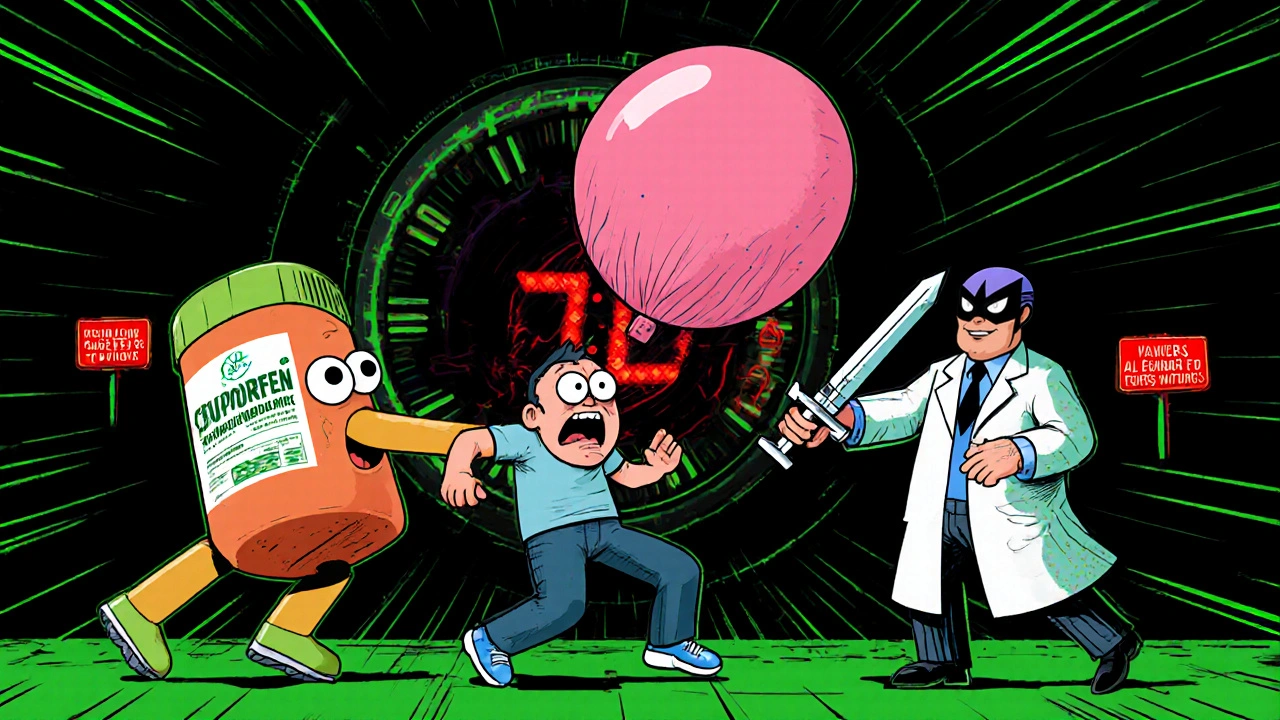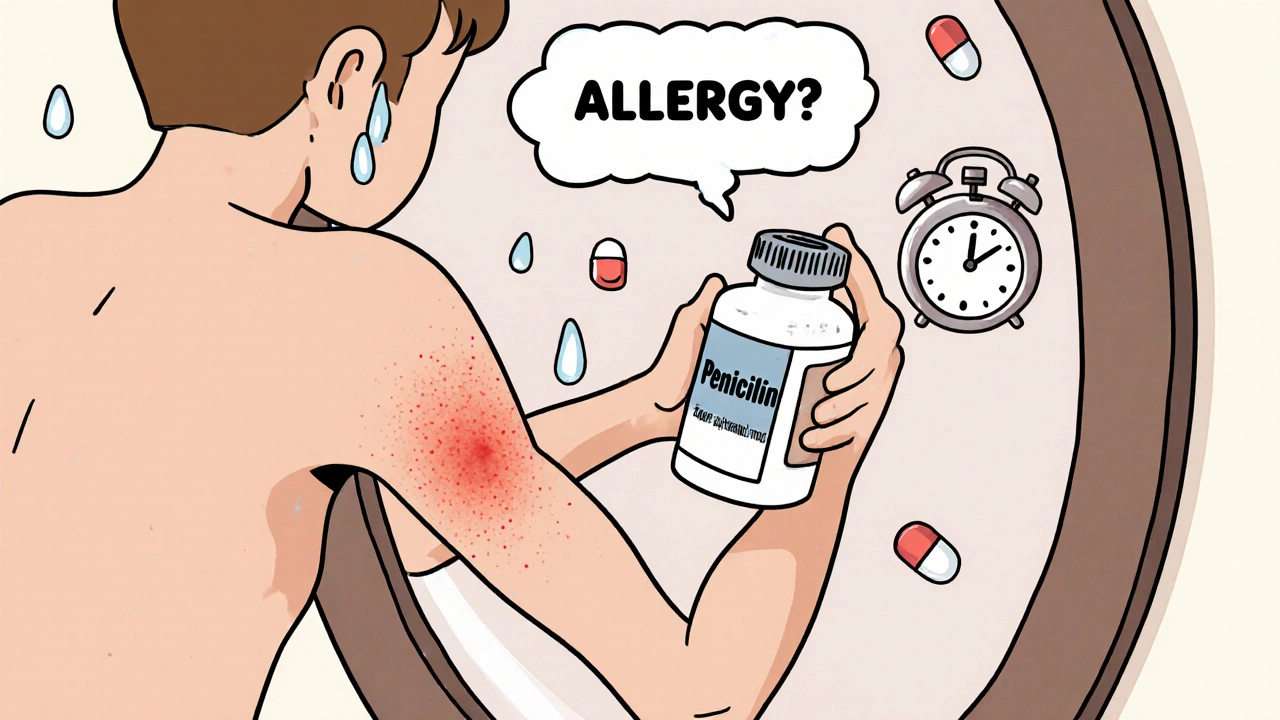Medication Reaction Severity Checker
Check Your Reaction Severity
This tool helps you determine if your symptoms indicate a mild, moderate, or severe medication reaction. Remember: This is not medical advice.
Reaction Assessment
Select symptoms to see your reaction severity level
Not all drug reactions are allergies - and not all allergies are the same
You take a pill, and a few hours later, your skin breaks out in itchy red bumps. Or maybe your lips swell up after an antibiotic. Or worse - you feel your throat closing, your chest tightens, and you can’t breathe. All of these are reactions to medications, but they’re not all the same. Some are harmless. Others can kill you. The difference isn’t just in how bad it feels - it’s in what’s happening inside your body.
According to research, about 7 to 10% of people will have some kind of reaction to a medication. But only 10 to 15% of those are true allergic reactions. The rest? Side effects, intolerances, or fake alarms. That’s why knowing the difference between mild, moderate, and severe reactions isn’t just helpful - it’s life-saving.
Mild reactions: Itchy skin, no danger
Mild reactions are the most common. Think: a few red, itchy spots on your arms or chest. Maybe a rash that looks like hives but doesn’t spread beyond 10% of your skin. You might feel a little uncomfortable, but you’re not in danger. No trouble breathing. No swelling in your throat. No drop in blood pressure.
These are usually Type I (IgE-mediated) or Type IV (delayed T-cell) reactions. Penicillin and sulfa drugs are the usual suspects. But here’s the twist: 80% of people who think they’re allergic to penicillin aren’t. They had a rash years ago, got labeled allergic, and never got tested. That leads to doctors giving them stronger, more expensive, or less effective antibiotics - just because of a mislabel.
What to do? Stop the drug. Take an over-the-counter antihistamine like loratadine or cetirizine. The rash usually fades within 24 to 48 hours. No ER visit needed. But don’t ignore it. Even mild reactions can be a warning sign. If it comes back with the same drug, or gets worse next time, that’s when you need to see an allergist.
Moderate reactions: Systemic symptoms - time to pay attention
Moderate reactions mean your body is reacting more broadly. The hives spread to 10-30% of your skin. You might have swelling in your face, eyelids, or hands - called angioedema. Maybe a low-grade fever (38.5-39.5°C), nausea, or joint pain. You’re not in shock, but you’re not fine either.
This is where things get tricky. A lot of people wait to see if it gets worse. That’s dangerous. Moderate reactions often come from NSAIDs like ibuprofen or naproxen. In fact, about 0.1% of people who take these drugs get this level of reaction. And 75% of them clear up in 72 hours with steroids - but only if they get treated early.
Here’s what you need to do: Stop the drug immediately. Call your doctor. You’ll likely need a short course of oral corticosteroids like prednisone. You may need to be observed for 4 to 6 hours. Don’t drive yourself. Don’t wait until tomorrow. Even if you feel okay now, symptoms can spike unexpectedly.
One big red flag: If you’ve had a mild reaction before and now you’re having a moderate one, you’re at higher risk for a severe reaction next time. That’s not speculation - it’s clinical fact. Your immune system is learning to react more aggressively.

Severe reactions: Emergency - act now
Severe reactions are medical emergencies. They happen fast. Minutes, sometimes seconds. And they can kill.
Anaphylaxis is the most dangerous Type I reaction. You feel it: throat closing, wheezing, dizziness, rapid pulse, cold sweat, vomiting, or loss of consciousness. Your blood pressure crashes below 90 mmHg. Your oxygen level drops under 90%. This isn’t a bad rash - it’s your body going into full collapse.
Then there are the delayed but deadly Type IV reactions: Stevens-Johnson Syndrome (SJS) and Toxic Epidermal Necrolysis (TEN). These start with flu-like symptoms - fever, sore throat, burning eyes - then a painful red rash spreads. Blisters form. Skin peels off in sheets. Up to 30% of your body can detach. Mortality? 5-15% for SJS. 25-35% for TEN. You don’t recover at home. You need a burn unit.
Other severe reactions include DRESS syndrome (drug reaction with eosinophilia and systemic symptoms), which can wreck your liver, kidneys, or lungs. Or agranulocytosis - your white blood cell count plummets, leaving you defenseless against infection.
If you suspect a severe reaction: Use your epinephrine auto-injector immediately. Call 911. Don’t wait. Don’t hope it’ll pass. Epinephrine is the only thing that can reverse anaphylaxis. Antihistamines and steroids don’t cut it in an emergency.
Why confusion happens - and why it’s deadly
People mix up side effects with allergies all the time. Vancomycin can cause red man syndrome - flushing, itching, rash - but it’s not an allergy. It’s a reaction to how fast the drug is given. Slow the infusion, and it goes away. No epinephrine needed.
Another big problem? Doctors miss it. A patient gets a rash and is told, “It’s just a side effect.” They keep taking the drug. Three days later, they’re in the ICU with 25% of their skin peeling off. That’s not rare. There are dozens of forum posts from people who were told to “just keep taking it” - until it was too late.
And here’s the kicker: 15-20% of severe reactions don’t fit neatly into any category. They’re mixed - IgE and T-cell responses happening together. The old classification system doesn’t catch them. That’s why new guidelines now call them Type VII reactions.

What you should do - step by step
- Know your triggers. If you’ve had any reaction before, write it down: what drug, what symptoms, how long after, what helped.
- Don’t guess. If you think you’re allergic to penicillin, get tested. Skin tests and blood tests are accurate and safe. You might find out you’re not allergic at all.
- Carry an epinephrine auto-injector if you’ve had anaphylaxis before. Keep it with you. Check the expiration date. Teach your family how to use it.
- Wear a medical alert bracelet. Especially if you’ve had SJS, TEN, or anaphylaxis. Emergency responders need to know immediately.
- Ask before taking anything new. Even over-the-counter drugs. Herbal supplements. Vaccines. All can trigger reactions.
- Insist on documentation. Your medical record must say: “Urticaria covering 15% body surface area after amoxicillin, resolved with antihistamines.” Not just “allergic to penicillin.” Specifics save lives.
What’s changing - and what to expect
Things are getting better. By 2025, all U.S. electronic health records will be required to include standardized tools to assess reaction severity. That means your doctor won’t just write “rash” - they’ll pick from a checklist: skin area affected, vital signs, organ involvement.
Genetic testing is coming fast. If you’re of Asian descent and your doctor wants to prescribe carbamazepine (for seizures or nerve pain), they’ll check for the HLA-B*15:02 gene. If you have it, your risk of SJS is 10 times higher. That test takes 24 hours. It’s cheap. It’s life-saving.
And the diagnostics market? It’s growing. Skin tests, blood tests, lymphocyte tests - all improving. But here’s the truth: most community clinics still don’t have the tools or training. Only 45% of them properly assess severity. Academic hospitals? 85%. If you’ve had a moderate or severe reaction, go to a specialty allergy clinic. Don’t settle for a general practitioner.
Bottom line: Don’t ignore the signs - but don’t panic either
Most drug reactions are mild. Most people who think they’re allergic aren’t. But when it’s serious, there’s no second chance.
Learn the difference. Know your body. Speak up. If you’re unsure, get tested. If it’s bad, act fast. Epinephrine saves lives. Delay kills.
The goal isn’t to avoid all medications. It’s to use them safely. And that starts with knowing exactly what kind of reaction you’re dealing with - and what to do next.


Comments
Mark Kahn
November 21, 2025 AT 22:10Leo Tamisch
November 22, 2025 AT 18:17Shawn Sakura
November 23, 2025 AT 17:11Julia Strothers
November 25, 2025 AT 01:10Erika Sta. Maria
November 26, 2025 AT 13:38Nikhil Purohit
November 27, 2025 AT 21:43Debanjan Banerjee
November 28, 2025 AT 13:33Steve Harris
November 30, 2025 AT 05:45Michael Marrale
December 1, 2025 AT 13:52David vaughan
December 2, 2025 AT 09:59Cooper Long
December 2, 2025 AT 10:31Sheldon Bazinga
December 4, 2025 AT 05:59Sandi Moon
December 5, 2025 AT 14:58Kartik Singhal
December 5, 2025 AT 17:56